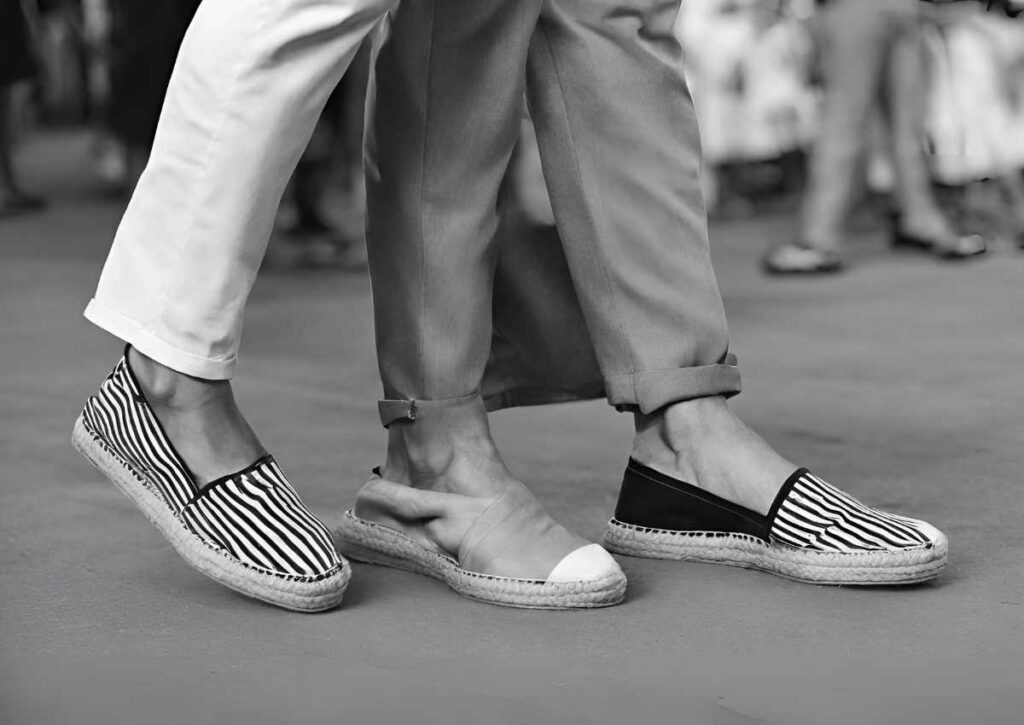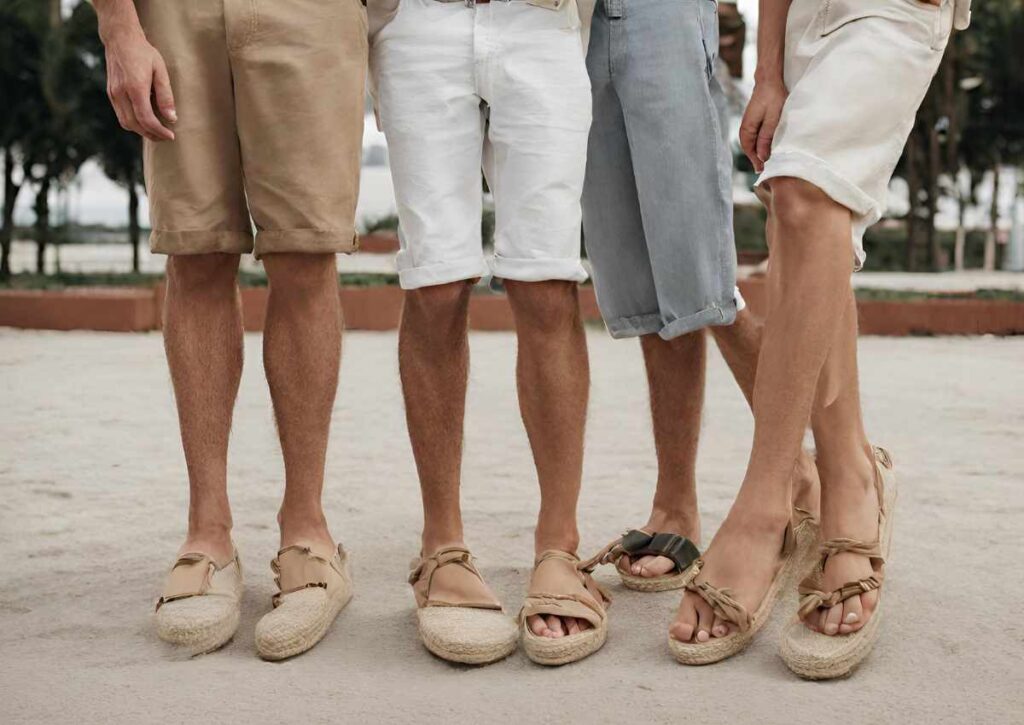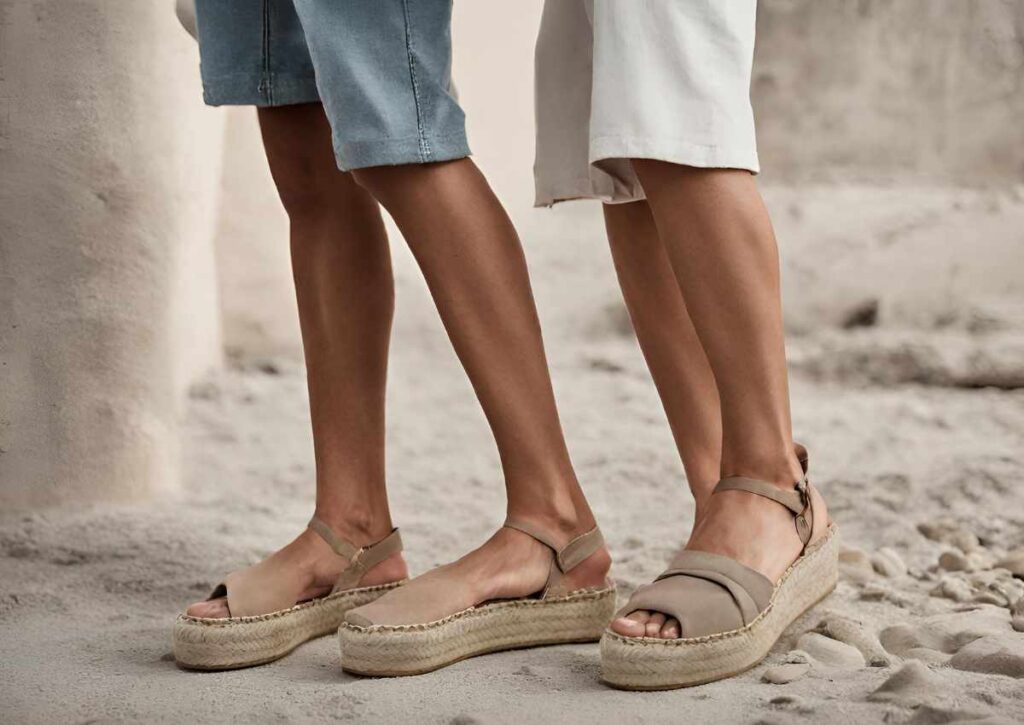Espadrilles, known as “alpargatas” or “esparteñas” in Spanish, “espardenyes” in Catalan, and “espartinak” in Basque, embody a rich tapestry of history and culture.
These casual, rope-soled shoes, characterised by their esparto rope soles and canvas or cotton uppers, have traversed centuries, continents, and social classes, evolving from humble peasant footwear to iconic fashion statements.
Let’s delve into the fascinating Espadrilles history, exploring their origins, etymology, and enduring legacy.
Origins And Etymology
The roots of espadrilles dig deep into the soil of Spain, particularly the regions of Catalonia, Aragon, and the Basque Country.
The term “espadrille” itself is derived from the Occitan language, closely related to Catalan, where it stems from “espardenya” or “alpargata” in Spanish, both referring to shoes crafted with esparto.
Basque culture adds its own nuance, calling them “espartinak.” This linguistic diversity reflects the widespread popularity and adaptation of espadrilles across various regions and cultures.
Espadrilles History And Significance

Espadrilles boast a long and storied history, dating back to at least the 14th century, where they served as the footwear of choice for peasants and farmers across Europe.
The earliest iterations of these shoes featured simple canvas uppers seamlessly stitched to esparto rope soles, providing comfort and durability for laborious tasks in agricultural settings.
Over the centuries, espadrilles evolved from practical workwear to fashionable attire, gaining traction among artists, intellectuals, and cultural icons.
Notable figures like Picasso, Salvador Dalí, and later, John F. Kennedy and Yves Saint Laurent helped elevate espadrilles from rustic origins to symbols of artistic expression and leisure.
Global Spread And Modern Evolution

While Spain remains synonymous with espadrille production, globalisation and shifting manufacturing trends have seen production expand to countries like Bangladesh, the world’s leading jute producer.
This expansion underscores the enduring appeal and commercial viability of espadrilles in today’s fashion landscape.
Modern espadrilles come in a myriad of styles, materials, and designs, catering to diverse tastes and preferences.
From traditional flat soles to trendy wedges and platforms, espadrilles have evolved to suit contemporary fashion trends while retaining their timeless charm.
Cultural Significance

Beyond their fashion appeal, espadrilles hold cultural significance in regions like Argentina and Uruguay, where they have become integral parts of traditional attire and everyday wear.
Known as “alpargatas,” they were adopted by rural workers as practical alternatives to leather boots, symbolizing resilience and cultural heritage.
In the United States, the resurgence of espadrilles in the 1940s and 1980s, fueled by cinematic and pop culture references, further solidified their status as iconic footwear.
From Hollywood starlets to Miami Vice detectives, Espadrilles captivated audiences with their effortless style and laid-back elegance.
Manufacturing Process
Crafting espadrilles is a meticulous process that combines traditional craftsmanship with modern techniques.
The production begins with braiding jute twines into soles, which are then shaped and pressed to form the distinctive rope sole.
Uppers, ranging from classic canvas to luxurious fabrics, are then affixed to the soles, creating the final product.
Conclusion
In conclusion, the history of the Espadrilles is a testament to the enduring appeal of timeless craftsmanship and cultural heritage.
From humble beginnings as peasant footwear to global fashion staples, espadrilles have transcended boundaries, weaving themselves into the fabric of diverse societies and styles.
Whether strolling along the Spanish coast or strutting down city streets, the allure of espadrilles endures as a symbol of comfort, style, and heritage.
FAQs
What is the origin of espadrilles?
Espadrilles have their origins in Spain, particularly in regions like Catalonia, Aragon, and the Basque Country.
The term “espadrille” derives from the Catalan word “espardenya,” referencing the esparto grass used to make their distinctive rope soles.
How have espadrilles evolved over time?
Originally worn as peasant footwear, espadrilles have evolved into fashionable shoes, popularised by cultural figures like Picasso and Salvador Dalí.
They’ve transitioned from simple canvas uppers to a wide range of styles, including wedge-shaped designs introduced by Yves Saint Laurent.
What cultural significance do espadrilles hold in Argentina and Uruguay?
In Argentina and Uruguay, espadrilles, known as “alpargatas,” became integral parts of gaucho attire, symbolising resilience and heritage.
They were adopted by rural workers as practical substitutes for traditional leather boots and were associated with working-class identity.
Are espadrilles primarily designed for women?
While modern espadrilles are predominantly associated with women’s fashion, they are available in styles for both men and women.
From classic flat soles to trendy wedges, espadrilles cater to diverse tastes and preferences.
What materials are used to make espadrilles?
Espadrilles traditionally feature canvas or cotton uppers and soles made of esparto rope.
However, modern variations may incorporate a variety of materials, including leather, jute, and synthetic fibres, offering versatility in style and design.
How are espadrilles manufactured?
Crafting espadrilles involves a meticulous process that combines traditional craftsmanship with modern techniques.
Jute twines are braided into soles, shaped, and pressed to form the distinctive rope sole. The uppers are then affixed to the soles, resulting in the finished product.
Also Read
Drill Line: Enhancing Efficiency With Precision Drilling









